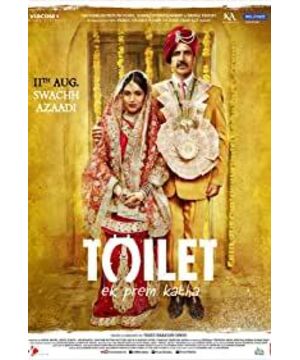Maybe up to now, there are still people who can't believe that the toilet tool of Indians is the left hand. Sales of toilet paper for toilets in India are low and expensive. With many Indian toilets, there is simply no place for toilet paper. Instead, there's a sink or tumbler next to the toilet, within easy reach. After a scoop of toilet, use the left hand to clean the back garden flowers with the spray. The specific operation of the process depends on personal preference, and you can choose to wipe, pull, or wipe. When you're done, wash your dirty hands with water in the sink. In better conditions, there will also be a small spray faucet for easy flushing.
We, who are used to toilet paper, naturally find this series of actions extremely disgusting. But as you may know, it's not that Indians don't love clean hands, but because they love clean hands too much. In their eyes, the person who wipes his butt with toilet paper is the most incredible existence.
First of all, in terms of cleanliness, washing with water is indeed cleaner than wiping with paper. If they don't want to leave feces on their bodies all day, they will choose to use their hands first and then wash them with water. They think it's a good habit. In addition to cleaning, it can also reduce the friction of paper on the anus, which is beneficial to reduce the occurrence of diseases such as hemorrhoids. In India, the biggest function of the left hand is to wash the buttocks, and avoid the left hand as much as possible when dealing with people or eating. Because of the taboo of filth, Indians also feel that it is very impolite to use the left hand. In fact, the fundamental contradiction between paper wipes and hand washing is that Indians feel that the feces left on the buttocks are more disgusting, and we feel that the direct contact between hands and feces is more disgusting. And this cognitive bias is difficult to reconcile.
But in fact, direct hand cleaning is indeed a bad choice. With the public health conditions in India, it is difficult to ensure the cleanliness of the left hand after going to the toilet. Like some public toilets, there is not even a running water, only a large bucket of water for everyone to use. After a few rounds, an indescribable layer of precipitation develops at the bottom of the barrel. In addition, Indians say that they only eat with their right hands, but I have never seen anyone who can cook with one hand. Therefore, the problem of cross infection is inevitable. "Food and germs coexist, eating is equal to eating shit", this is true. In fact, a better way to wipe your ass than hand "paper" or hand "finger" should be to rinse with a spray head or use a toilet bowl. First wipe with a paper towel, then turn on the faucet to rinse, and finally dry with a paper. This will not contaminate the hands, and the cleanliness of the buttocks will also be improved to a certain extent.
However, for Indians, the contradiction between cleaning with hands, paper or water is not the most serious. The key problem with toilets in India at the moment is not there either. More importantly, where will they solve the problem. Every morning, the following scenes can be seen in villages and towns in India. Taking advantage of the sunrise, one group of men and one group of women walked out of the village with the kettles in their hands. They will consciously find a corner or grass, and untie their trousers to release the power of the flood that has been held back all night. In addition to hand "paper", another label in India is "the world's largest open-air toilet".
Worldwide, the number of people who relieved their hands outdoors dropped to 950 million as early as 2015. But according to the World Toilet Day 2017 report by WaterAid, there are still about 732 million people in India without toilets today. As a major global outdoor reliever, even some backward African countries cannot catch up with this bad habit of urinating everywhere. If these Indians were in a line, they could circle the earth four full times. The daily "open defecation" in India can fill 16 Boeing planes. Whether in urban or rural areas, along the road, beside the railroad track, or on the beach, you can see Indians excreting freely.
In fact, human defecation has a long history, and as long as there are people, there will be an open-air toilet. But when population density increases, the troubles of open defecation cannot be underestimated. If you don't talk about hygiene, you will be backlashed. In India, one in ten deaths is related to poor public health. A World Bank study found that the lack of toilets and other sanitation facilities cost India $54 billion a year in lost productivity due to hygiene-related diseases. Bacteria account for one-third of the dry weight of feces, and one gram of feces contains 10 million viruses and 1 million bacteria. The excrement in the mountains and plains not only breeds a large number of bacteria, but also attracts a large number of blue wings to breed here. Flies flying everywhere, once again bringing feces and bacteria to human habitation. In addition, with just one rain, nearby drinking water sources are highly likely to be contaminated. The biggest source of infections such as dysentery, cholera and typhoid is feces, which are spread through contaminated hands, water, food and water supplies. Every year, more than 100,000 children under the age of 5 die from diarrhoea in India. Millions of people suffer from chronic intestinal infections that prevent them from absorbing nutrients and medicines better. According to a 2016 report, as many as 40% of children under the age of 5 in India are stunted. Hygiene issues are like an endless cycle, and children with stunted growth and low immunity are also more vulnerable to disease.
In addition to health problems, the lack of toilets is a catalyst for violence and crime. Statistics show that half of all rape cases in India occur when women go to the toilet in the open air. Women are always less bold than men, and they seldom defecate in broad daylight. They usually only quietly hide before sunrise and after sunset to solve problems. In addition to being vulnerable to snake bites, it also increases their risk of assault. For safety's sake, women generally set up "urinal associations" that focus on female partners. But people have three priorities, and there will always be women who can't hold back collective action. And the vast majority of rape and murder cases happen to these women who go to the rescue alone. In 2012, a survey in India found that 9 out of 10 women and girls said they had been harassed in the wild, and 1 in 3 women said they had been attacked.
Having time to work together may not work. In 2014, a pair of sisters in Uttar Pradesh, India, were unfortunately gang-raped and hanged from a tree while they were freeing together.
In 2011, Anita Narre, a woman in Madhya Pradesh, India, ran away from her husband's house without a toilet and filed for divorce. This news caused an uproar in India, and was later made into a movie by Bollywood, which was "Toilet Hero" released some time ago. In addition to the "movie that changed the fate of 600 million women" in the slogan, the film also explained the dilemma of building toilets in India.
The most important thing is that the "dirty and clean" caused by religious issues. Drinking cow urine, washing Ganga water, etc. is breathtaking enough, and even open defecation is considered holy in India. The traditional teaching of Hinduism is to encourage people to relieve themselves outdoors. According to legend, nature has the ability to purify, dirty things should be turned into nature, and the garbage all over India is also blessed by this teaching. Of course they think that excrement is filth, so they also take it for granted that unclean things must not be left in the home.
In general, only the untouchables of the lowest caste come into contact with excrement. Installing a toilet at home will not only blaspheme the gods, but it will also become equal to the pariah and lose dignity. For example, in the movie "Toilet Hero", the family that the heroine is married to is Brahmin, which belongs to the highest caste class. Her father-in-law was firmly opposed to building a toilet at home, and even the neighbors mocked her for "forgetting her roots".
In fact, since 2014, India has launched the "Clean India" campaign. The top priority is the "toilet revolution", vigorously building and renovating toilets in India. Prime Minister Narendra Modi even more ambitiously promised to completely solve the problem of open defecation in India by 2019. It is not a casual statement that the government has really worked hard on the toilet issue, and more than 40 billion US dollars have been allocated for this operation. In addition to the 12,000 rupees per family, some poorer families will receive additional grants. Generally, the cost of building a toilet is about 20,000 rupees (equivalent to about 2,000 yuan). Now Indian residents only need to pay a quarter of the money, which is 500 yuan, to have a private toilet. Therefore, low household income is really not the biggest obstacle to building toilets.
To achieve this goal, at least 60 million toilets must be built, but at the current rate, the goal may be difficult to achieve. In 2015, India only built 4.9 million toilets. In 2016, it was slightly better, with 5.8 million. In addition, these built toilets, people are not necessarily willing to use. From 1990 to 2015, data show that the rate of open defecation in India has dropped from 75% to 44%. But the reality is that this estimate reflects only the number of public toilets built, not the number of toilets actually used. In 2016, Rice University in the United States conducted such an Indian toilet survey. They found that in the 300 Indian villages and towns that have achieved "every house has a toilet", 40% of the residents still choose to relieve themselves outdoors. Some of the toilets that have been built at a great price have been left unused, some have been turned into small shops, some are used to store grain, and some are full of livestock. Some people are even more calm, and they apply for this fund to build an extra house.
In order to make Indians go to the toilet well, the government is only curious and has a lot of tricks, and the content is very magical. For example, the controversial "public humiliation" strategy has made villagers laughing at open defecation. They will use TV public service announcements, the Internet and outdoor billboards to blame those who excrete outdoors. Those unruly citizens will also be photographed and posted on a special website. In some parts of India, "Good Morning Squads" have been established. Their task is to patrol villages in the early morning and publicly humiliate those who defecate outdoors. No distinction is made between men and women, young and old. The small bucket in their hands will be taken away and confiscated, and replaced by a flower and some education. ·
In urban areas, the government has also dispatched special water trucks, and once someone is found to be urinating everywhere, they will be served with high-pressure water guns. And in some areas, people who don't use toilets could face losing benefits or running for office. Those who do not change their teachings will also be locked up or fined 500 rupees. In addition to penalties, of course there are rewards. In order not to pollute the city with excrement, the Ahmedabad Municipal Council stipulates that every time you go to a public toilet, you can get 1 rupee. Although there are few, but comparing with the public toilets that charge money, you can see the good intentions of the Indian government.
In order to promote toilet culture, Indian women even launched a "no toilet, no wife" campaign. "Toilet Hero" is also a pioneer in answering the call. "Not repairing toilets equals domestic violence," urging women to reject suitors who don't have bathrooms at home. To do this, there is really no one except India. It is very difficult to change a person's habits, what India needs to do now is to change the whole nation.
View more about Toilet: A Love Story reviews











